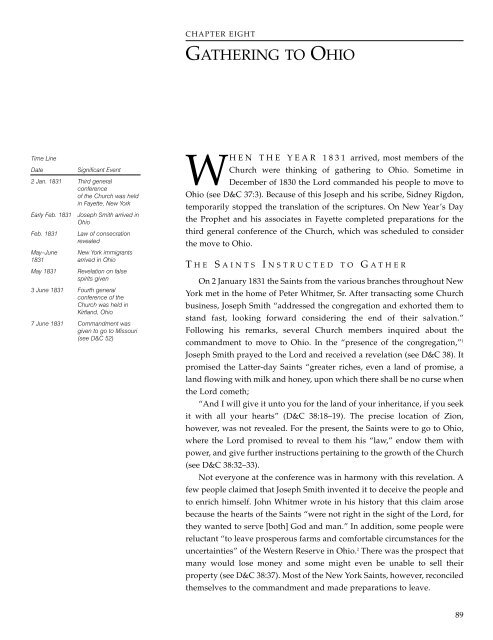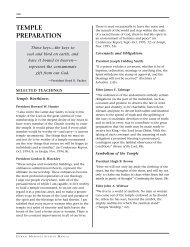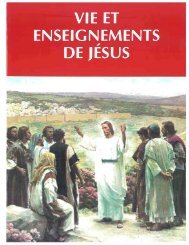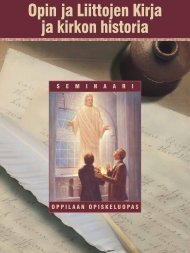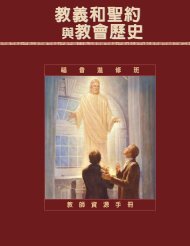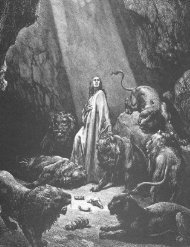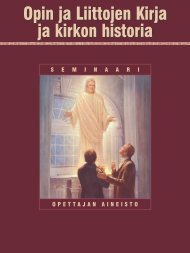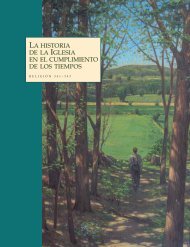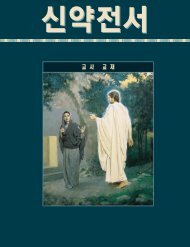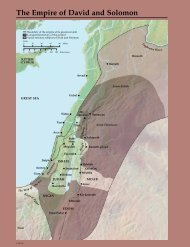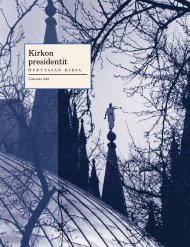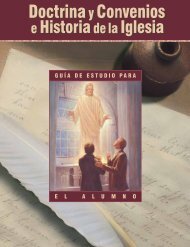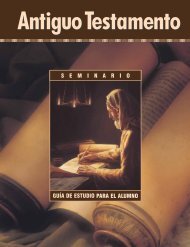Chapter Eight
Chapter Eight
Chapter Eight
You also want an ePaper? Increase the reach of your titles
YUMPU automatically turns print PDFs into web optimized ePapers that Google loves.
CHAPTER EIGHTGATHERING TO OHIOTime LineDateSignificant Event2 Jan. 1831 Third generalconferenceof the Church was heldin Fayette, New YorkEarly Feb. 1831Feb. 1831Joseph Smith arrived inOhioLaw of consecrationrevealedMay–June New York immigrants1831 arrived in OhioMay 1831 Revelation on falsespirits given3 June 1831 Fourth generalconference of theChurch was held inKirtland, Ohio7 June 1831 Commandment wasgiven to go to Missouri(see D&C 52)WHEN THE YEAR 1831 arrived, most members of theChurch were thinking of gathering to Ohio. Sometime inDecember of 1830 the Lord commanded his people to move toOhio (see D&C 37:3). Because of this Joseph and his scribe, Sidney Rigdon,temporarily stopped the translation of the scriptures. On New Year’s Daythe Prophet and his associates in Fayette completed preparations for thethird general conference of the Church, which was scheduled to considerthe move to Ohio.T HE S AINTS I NSTRUCTED TO G A THEROn 2 January 1831 the Saints from the various branches throughout NewYork met in the home of Peter Whitmer, Sr. After transacting some Churchbusiness, Joseph Smith “addressed the congregation and exhorted them tostand fast, looking forward considering the end of their salvation.”Following his remarks, several Church members inquired about thecommandment to move to Ohio. In the “presence of the congregation,” 1Joseph Smith prayed to the Lord and received a revelation (see D&C 38). Itpromised the Latter-day Saints “greater riches, even a land of promise, aland flowing with milk and honey, upon which there shall be no curse whenthe Lord cometh;“And I will give it unto you for the land of your inheritance, if you seekit with all your hearts” (D&C 38:18–19). The precise location of Zion,however, was not revealed. For the present, the Saints were to go to Ohio,where the Lord promised to reveal to them his “law,” endow them withpower, and give further instructions pertaining to the growth of the Church(see D&C 38:32–33).Not everyone at the conference was in harmony with this revelation. Afew people claimed that Joseph Smith invented it to deceive the people andto enrich himself. John Whitmer wrote in his history that this claim arosebecause the hearts of the Saints “were not right in the sight of the Lord, forthey wanted to serve [both] God and man.” In addition, some people werereluctant “to leave prosperous farms and comfortable circumstances for theuncertainties” of the Western Reserve in Ohio. 2 There was the prospect thatmany would lose money and some might even be unable to sell theirproperty (see D&C 38:37). Most of the New York Saints, however, reconciledthemselves to the commandment and made preparations to leave.89
CHURCH HISTORY IN THE FULNESS OF TIMESJohn Whitmer (1802–78) was the first presidingelder of the Kirtland Saints until Joseph Smitharrived in February 1831.Newel K. Whitney (1795–1850) was asuccessful businessman as well as prominentin civic affairs. In 1844 he was sustained as thesecond bishop in the Church, and in 1847 as thefirst Presiding Bishop.Following the conference, Joseph Smith and Sidney Rigdon went toColesville to strengthen the members of the Colesville branch and to preachfor the last time to nonmembers in the vicinity. Threats on their livesprevented them from extended proselyting. Upon their return to Fayette,the Prophet sent John Whitmer to Ohio with copies of several of therevelations to comfort and strengthen the Saints. Brother Whitmer was alsoassigned to be their presiding elder until the arrival of the Prophet. By thetime he arrived in Kirtland, the membership of the Church in Geauga andCuyahoga counties in Ohio had swelled to about three hundred, more thantwice the number reported only two months earlier. 3 Since the departure ofthe missionaries to the Lamanites, proselyting in the area had continuedunabated. One of the most successful missionaries was the formerrestorationist preacher, John Murdock. Between November 1830 and March1831, he baptized over seventy settlers living in Cuyahoga County. 4 Othermissionaries fared equally well in their labors in Ohio.G ATHERING TO O HIO B EGINSMoving to Ohio was advantageous to the young Church. By leavingNew York the Saints hoped to leave behind religious persecution,particularly in the Colesville area. In addition, there were more Churchmembers in Ohio than anywhere else, and gathering in one place enabledeveryone to receive instructions from the Prophet, thus maintainingdoctrinal and organizational uniformity. Ohio’s available waterways alsoprovided a gateway to the rest of the country for missionary work. But,most important, the move to Ohio was a step closer to “the borders by theLamanites,” where Zion would be established (D&C 28:9). In Ohio manyprinciples pertaining to the building of Zion could be implemented.Joseph Smith was eager to meet with the Saints in Ohio, and JohnWhitmer wrote urging him to come right away. Joseph sought the Lord’swill and was told to leave immediately, but the prospect of moving seemedgrim to Emma. She had moved seven times in the first four years ofmarriage and was just recovering from a month-long illness in addition tobeing six months pregnant. Under such conditions the three-hundred miletrip to Ohio in the dead of winter was arduous at best. Joseph Knightgraciously provided a sleigh to make traveling less strenuous for her. At theend of January 1831, Joseph and Emma Smith, Sidney Rigdon, and EdwardPartridge set out for Kirtland.About the first of February the sleigh pulled up in front of Newel K.Whitney’s store in Kirtland. Joseph sprang from the sleigh and entered thestore. “‘Newel K. Whitney! Thou art the man.’ he exclaimed, extending hishand cordially, as if to an old and familiar acquaintance. ‘You have theadvantage of me,’ replied the merchant, . . . ‘I could not call you by name asyou have me.’ ‘I am Joseph the Prophet,’ said the stranger smiling. ‘You’veprayed me here, now what do you want of me?’” Joseph explained to the90
GATHERING TO OHIOThe Newel K. Whitney store, located at the fourcorners area in Kirtland, was built between 1826and 1827. Many important things took placethere, including the following:1. Joseph and Emma Smith lived therebeginning in the fall of 1832.2. The store became the headquarters of theChurch.3. Joseph Smith III was born there on6 November 1832.4. The School of the Prophets, whichcommenced on 24 January 1833 and endedsometime in April, was held there.5. Many revelations were given there to theProphet Joseph Smith, including Doctrine andCovenants 84, 87–89, 95, and 98.6. For a time the store was used as thebishops’ storehouse.7. Joseph Smith completed much of thetranslation of the Bible there.In 1979 the Church acquired the Newel K.Whitney store and soon after began to restore it.The building was dedicated 25 August 1984 byPresident Gordon B. Hinckley.amazed merchant that back in New York he had seen Newel in a visionpraying for him to come to Kirtland. 5 The Whitneys received Joseph andEmma Smith with kindness and invited them to live temporarily with them.During the next several weeks the Smiths “received every kindness andattention which could be expected, and especially from Sister Whitney.” 6Between the end of January and the middle of May 1831, most of theNew York Saints sold their possessions, packed their most precious materialgoods, and migrated to Kirtland and the adjacent areas. Joseph Smith and afew others went early and were followed by three separate companies—theColesville Saints, members from Fayette and surrounding locations inSeneca County, and those from Palmyra-Manchester. A few others camelater in the year.The Colesville branch was the first group to leave. They arrived in Buffaloon 1 May to find that bitter lake winds had blown ice into the Buffalo harbor,which delayed them for eleven dreary days. They finally arrived in Fairport,Ohio, on 14 May. Over two hundred people went to Ohio, some by sleigh andstage coach, but most by canal barges to Buffalo and then by steamboatsand schooners on Lake Erie.Meanwhile Church members in the Fayette vicinity also prepared formigration. With her older sons and husband already gone, Lucy Smith, anatural leader in her own right, organized a party of about fifty people (twentyadults and thirty children) to occupy a barge on the Cayuga and Seneca Canal.Another group of about thirty, organized by Thomas B. Marsh, took passage onan accompanying barge, and together the two boats traveled to Buffalo.En route, Lucy “called the brethren and sisters together, and remindedthem that we were traveling by the commandment of the Lord, as much asFather Lehi was, when he left Jerusalem; and, if faithful, we had the same91
CHURCH HISTORY IN THE FULNESS OF TIMESLucy Mack Smith (1776–1856)reasons to expect the blessings of God.” 7 Although they suffered fromhunger because some had brought clothing rather than food, they sang andprayed as they journeyed and left a favorable impression on the captain.Lucy took charge of the situation and prevented greater suffering.When they arrived in Buffalo, they met the icebound Colesville Saints.After several anxious days in Buffalo, a number of the children had becomesick, and many of the group were hungry and discouraged. They took deckpassage on a boat, put their things on board, and obtained temporaryshelter for the women and children until early the next morning. When theywere back on board, Lucy persuaded the still murmuring group to ask theLord to break the twenty-foot clogs of ice that jammed the harbor. Sheexplained, “A noise was heard, like bursting thunder. The captain cried,‘Every man to his post.’ The ice parted, leaving barely a passage for theboat, and so narrow that as the boat passed through the buckets of thewaterwheel were torn off with a crash. . . . We had barely passed throughthe avenue when the ice closed together again.” The Colesville groupfollowed a few days later. 8As these New York Saints were arriving in Ohio, a third party of about fiftypeople left Palmyra, New York, under the direction of Martin Harris. Withtheir arrival in Ohio, the first phase of the westward movement of the LatterdaySaints ended. In contrast to many Americans who migrated westward atthe same time seeking free or inexpensive land, adventure, or escape fromcreditors, these humble people moved in response to a commandment ofGod. 9E ARLY C HALLENGES IN O HIO92During the three months Joseph Smith was in Kirtland before the Saintsfrom New York began to arrive, he faced many challenges arising from therapid growth of the Church there. The first problem was the manifestation of“strange notions and false spirits” among the members of the branch. 10Because they lacked the guidance of Church authorities in northern Ohio,some new members entertained “wild enthusiastic notions” about the effectsof the Holy Spirit upon the converted. John Corrill, an early Ohio convert,was disturbed by the bizarre actions of some of the young people whoclaimed they saw visions: “They conducted themselves in a strange manner,sometimes imitating Indians in their maneuvers, sometimes running out intothe fields, getting on stumps of trees and there preaching as thoughsurrounded by a congregation,—all the while so completely absorbed invisions as to be apparently insensible to all that was passing around them.” 11Satan’s inroads in the Church were due to the credulity and gullibility ofthese new Saints who brought some of their previous ways with them andwere without priesthood direction for a few months.Only a few members behaved in this manner, however. “The moresubstantial minded looked upon it with astonishment, and were suspiciousthat it was from an evil source.” 12 Distressed by what he saw, Joseph felt thatthese excesses were “calculated to bring disgrace upon the church of God; to
GATHERING TO OHIOcause the spirit of God to be withdrawn; and to uproot and destroy thoseglorious principles which had been developed for the salvation of the humanfamily.” 13 “With a little caution and some wisdom” and the guidance ofseveral revelations, he succeeded in overcoming these problems. 14Still, in late February 1831, some individuals continued to claim they hadreceived revelations. This was not a new problem; Hiram Page had done thesame thing in Fayette the previous fall (see D&C 28). One of these so-called“revelators” was a professed prophetess named Hubble, who claimed sheshould be allowed to become a teacher in the Church. According to JohnWhitmer, she “appeared to be very sanctimonious and deceived some whowere not able to detect her in her hypocrisy.” Many saw through her falseclaims, however, and “her follies and abominations were made manifest.” 15The Prophet inquired of the Lord about her stratagems. In a revelationdirected to the elders of the Church, the Lord declared “that there is none otherappointed unto you to receive commandments and revelations until [JosephSmith] be taken, if he abide in me” (D&C 43:3). So-called revelations throughothers for the guidance of the Church were not of God (see D&C 43:4–6).Shortly thereafter another revelation called the elders to go forth bytwos in all directions to preach the gospel (see D&C 44:1–3; 42:6–7). Soonmany elders were seen going into villages and towns throughout Ohio. Forexample, John Corrill recounted that he and Solomon Hancock “went toNew London, about one hundred miles from Kirtland, where we built up achurch [branch] of thirty-six members in about three weeks time, though wewere bitterly opposed by other preachers.” 16 That spring the Church in Ohioincreased by several hundred converts.The growing Church did not go unnoticed in northern Ohio. JosephSmith wrote that in the spring of 1831, “many false reports, lies, and foolishstories, were published in the newspapers, and circulated in everydirection, to prevent people from investigating the work, or embracing thefaith.” 17 For example, a devastating earthquake struck near Peking, China,which a young Mormon girl had predicted six weeks earlier. This eventconvinced Symonds Ryder, a well-known Campbellite preacher who hadbeen perplexed over Mormonism for some time, to join the Church. Hisconversion caused quite a disturbance in the vicinity, and the earthquakewas heralded in the newspapers as Mormonism in China. “But to the joy ofthe Saints who had to struggle against everything that prejudice andwickedness could invent,” the Prophet received a revelation that identifiednumerous signs that will precede the second coming of the Lord. 18 In it theSaints were commanded to “stand in holy places” and take “the Holy Spiritfor their guide,” and they were promised that they would be rewarded forthis with the establishment of the “New Jerusalem” (D&C 45:32, 57, 66).Also in the spring of 1831 a Methodist preacher named Ezra Boothbrought a party to Kirtland, which included a well-to-do farmer named John93
CHURCH HISTORY IN THE FULNESS OF TIMESJohnson and his wife, Alice, from Hiram, Ohio. Alice’s arm was partiallyparalyzed from rheumatism, and she could not raise it above her head. Asthey talked with the Prophet, one of the visitors asked if there was anyoneon earth who had the power to cure Alice’s lame arm. When theconversation turned to another subject, Joseph went up to Mrs. Johnson,took her by the hand, and with calm assurance said, “Woman, in the nameof the Lord Jesus Christ I command thee to be whole.” As Joseph went fromthe room, leaving everyone astonished and speechless, she raised her arm.The next day she hung out her first wash in over six years without any pain.Ezra Booth and some members of the Johnson family joined the Church as aresult of the healing. The miracle also attracted wide acclaimthroughout northern Ohio. 19That same spring Parley P. Pratt returned to Kirtland with a report onthe mission to the Lamanites and was delighted to see the tremendousgrowth of the Church. He was especially happy that Joseph had moved toOhio. Parley was soon called to go on a mission to a religious group calledthe Shakers in northern Ohio.The Shakers (United Society of Believers in Christ’s Second Coming)originated in England and came to America in 1774 because of persecution.“They derive their name from their manner of worship, which [involved]singing, dancing, and clapping hands” to music, but “their dress and mannerare similar to those of the [Quakers,] so they were sometimes called theShaking Quakers.” The Shaking Quakers were led by Ann Lee from 1754 to1784. She had claimed to be the Messiah returned to earth in female form. Shetaught that men and women were equals and that there should be no marriageamong the believers. 20 Leman Copley, a former Shaker, had converted toMormonism but still believed that the Shakers were correct in many of theirdoctrines, so he asked Joseph for guidance on the matter. 21 The revelationJoseph Smith received repudiated the Shaker doctrines of celibacy, abstainingfrom meat, and God appearing in the form of a woman. Sidney Rigdon, ParleyP. Pratt, and Leman Copley were also called to take the gospel to the Shakers(see D&C 49). The trio visited a settlement of Shakers near Cleveland, Ohio,but according to Parley, “they utterly refused to hear or obey the gospel.” 22Elder Pratt then visited a number of branches of the Latter-day Saints inthe Western Reserve, where he found the same spiritual fanaticism among themembers that Joseph Smith had encountered when he arrived in Kirtland inFebruary. Other elders were also disheartened by what they saw.John Whitmer related, “Some would fancy to themselves that they had thesword of Laban, and would wield it as expert as a light dragoon, some wouldact like an Indian in the act of scalping, some would slide or scoot on the floor,with the rapidity of a serpent, which termed sailing in the boat to theLamanites, preaching the gospel, and many other vain and foolish maneuvers,that are unmeaning and unprofitable to mention. Thus the devil blinded the94
GATHERING TO OHIOeyes of some good and honest disciples.” 23 Parley Pratt concurred that “afalse and lying spirit seemed to be creeping into the Church.” 24Uncertain how to handle these spiritual phenomena, the brethren joinedwith the Prophet in prayer in his translating room in Kirtland. Joseph thendictated a revelation (see D&C 50). Elder Pratt remembered the sublimeexperience of observing a revelation in process: “Each sentence was utteredslowly and very distinctly, and with a pause between each, sufficiently longfor it to be recorded, by an ordinary writer, in long hand.” 25The Lord began by acknowledging that there were many “false spirits,which have gone forth in the earth, deceiving the world” (D&C 50:2–3) andthat Satan was seeking to deceive the people that he might overthrow them.Therefore the Lord gave the brethren a key by which they could detect anddeal with evil spirits:“Wherefore, it shall come to pass, that if you behold a spirit manifestedthat you cannot understand, and you receive not that spirit, ye shall ask ofthe Father in the name of Jesus; and if he give not unto you that spirit, thenyou may know that it is not of God.“And it shall be given unto you, power over that spirit; and you shallproclaim against that spirit with a loud voice that it is not of God”(D&C 50:31–32).T HE L AW OF C ONSECRATIONNow settled in Kirtland, the Prophet was eager to know the Lord’s willconcerning the economic salvation of the Saints, many of whom wereimpoverished, particularly those who had left their homes in New York. Hisinterest in the Lord’s economic program was aroused when he arrived in Ohioand discovered a group of about fifty people who had established acooperative venture based on their interpretation of statements in the book ofActs, describing the early Saints as having all things in common (see Acts2:44–45; 4:32). This group, known as “the family,” formerly followers of SidneyRigdon, were members of the Church living on Isaac Morley’s farm near thevillage of Kirtland. When John Whitmer arrived in mid-January, he noted thatwhat they were doing created many problems. For example, Heman Bassetttook a pocket watch belonging to Levi Hancock and sold it. When asked why,Heman replied, “Oh, I thought it was all in the family.” Levi responded that hedid not like such “family doing” and would not endure it any longer. 26The Prophet Joseph, however, realized the need to establish a more perfectsystem to meet the growing economic needs of the Church. Revenue wasrequired to finance various Church undertakings, such as publishingrevelations and missionary tracts. The Prophet was without a home for hisfamily; Sidney Rigdon had lost his pastoral home and the economic support hehad previously received from his congregation. Money, goods, and propertywere needed to help the poor and to assist immigrants who were sacrificingmuch to gather to Ohio, so Joseph inquired of the Lord.95
CHURCH HISTORY IN THE FULNESS OF TIMESIn 1833 the Church purchased the PeterFrench farm, which eventually became the centerof the Church in Kirtland, as the close up andenlarged views show.BrighamYoungWilloughby RoadWhitney StorePeterFrenchFarmPrinting OfficeFrederick G.Williams FarmAsheryTempleMentor RoadTanneryIsaacMorleyFarmChagrChillicothe Roadi nR i v e rChardon RoadKirtland Flats to WilloughbyEastKirtland Flats to MentorBranch Chagrin RiverChillicothe RoadJohn Johnson InnNewel K.WhitneyHomeWhitneyStoreBrookOrson HydeTanneryKirtland Flatsto Painesvilleto ChardonAsheryJoseph Smith, Sr.Joseph SmithVariety StoreWhitney StreetParley P. PrattMethodist ChurchCemeteryJoseph SmithJohnsonPrintingOfficeTempleSidney RigdonCowdery StreetBankChillicothe (Smith) RoadJoseph StreetHyrum SmithOn 4 February 1831 the Prophet received a revelation calling for EdwardPartridge to serve as the first bishop of the Church, with instructions for him todevote his time to this calling (see D&C 41:9). Five days later another importantrevelation was received, embracing the law of the Church. It gave BishopPartridge further instruction on his responsibilities and outlined the neweconomic system (see D&C 42).One of the underlying principles of this new economic system was that theearth and everything on it belonged to the Lord, and man was a steward96
GATHERING TO OHIOA consecration deed of October 1832(see Psalm 24:1; D&C 104:13–14). Under the law of consecration membersof the Church were asked to consecrate, or deed, all their property, both realand personal, to the bishop of the Church. He would then grant an“inheritance,” or stewardship, to an individual from the properties received.The size of the stewardship depended on the circumstances, wants, and needsof the family, as determined jointly by the bishop and the prospective steward(see D&C 42:32–33; 51:3). The family then administered its stewardship to thebest of their ability. If they were industrious and successful, then at the97
CHURCH HISTORY IN THE FULNESS OF TIMESSignificant Revelations about the Law of Consecration and the United OrderDate Where Received Where Recorded Content4 Feb. 1831 Kirtland, Ohio D&C 41:9 Edward Partridge appointed as first bishop.9 Feb. 1831 Kirtland, Ohio D&C 42:30–34 Law of consecration explained.Feb. 1831 Kirtland, Ohio D&C 44:6 Saints to administer to the poor according to law.7 Mar. 1831 Kirtland, Ohio D&C 45:64–75 Call to gather Zion: prospect of New Jerusalem.Mar. 1831 Kirtland, Ohio D&C 48 Saints who settled in Ohio to save money forinheritance in Zion.May 1831 Thompson, Ohio D&C 51:3ff Bishop Partridge to appoint portions (stewardships)according to family size, circumstances, wants, and needs.Storehouse to be established.June 1831 Kirtland, Ohio D&C 56:16–20 Rich and poor commanded to repent.20 July 1831 Jackson County, Missouri D&C 57 Missouri appointed and consecrated as the land ofinheritance and center place for Zion.1 Aug. 1831 Jackson County, Missouri D&C 58:1–9, 50–57 Zion to come after much tribulation. Early immigrantshonored to lay foundation of Zion. Lands to bepurchased in Independence.Aug. 1831 Kirtland, Ohio D&C 63:27–31 Saints commanded to purchase lands with money andforbidden to obtain lands by blood.12 Nov. 1831 Kirtland, Ohio D&C 70:1–8 Elders appointed stewards over revelations. Surplusesto be consecrated to the Church.4 Dec. 1831 Kirtland, Ohio D&C 72 Newel K. Whitney appointed as second bishop of theChurch in Kirtland. Further duties of bishop made known.Mar. 1832 Hiram, Ohio D&C 78 Saints commanded to establish storehouses in Zion and tofurther organize so Church would be independent.26 April 1832 Jackson County, Missouri D&C 82:11–12 United order to be established to manage affairsin Zion and Kirtland.30 Apr. 1832 Independence, Missouri D&C 83 Widows and orphans to be provided for by consecrationof the Church to storehouses.27 Nov. 1832 Kirtland, Ohio D&C 85 To receive an inheritance in Zion a person must bewilling to live the law of consecration.25 June 1833 Kirtland, Ohio History of the Church, 1:364–65 Letter from the Prophet to Bishop Edward Partridgeon the size of a member’s stewardship.2 Aug. 1833 Kirtland, Ohio D&C 97:10–21 House (temple) in Zion (Jackson County) commanded.Zion is pure in heart.6 Aug. 1833 Kirtland, Ohio D&C 98 Saints commanded to follow the Constitution.Law of war and law of forgiveness given to Saints.12 Oct. 1833 Perrysburg, New York D&C 100:13–17 Chastened Zion to be redeemed.10 Dec. 1833 Kirtland, Ohio History of the Church, 1:453–56 Letter from the Prophet to retain lands: petitionto God to return Saints to land of inheritances.16 Dec. 1833 Kirtland, Ohio D&C 101 Reasons given for Saints’ expulsion from JacksonCounty. Zion not to be moved out of her place. Saintsto rely on constitutional process.24 Feb. 1834 Kirtland, Ohio D&C 103 Saints to redeem Zion after tribulation. Zionto be redeemed by power.23 Apr. 1834 Kirtland, Ohio D&C 104:47–66 Separation of united order in Kirtland and Zion.Sacred treasury provided for.22 June 1834 Fishing River, Missouri D&C 105 Redemption of Zion postponed until Saints are prepared,endowed, and numerous. United order dissolveduntil after Zion’s redemption.1 Sept. 1835 Kirtland, Ohio History of the Church, 2:254 Prophet’s letter to elders of the Church relating hisJune 1831 vision to go to western Missouri.(Adapted from William O. Nelson, Ensign, Jan. 1979, p. 23.)98
GATHERING TO OHIO The revelations to Joseph Smithconcerning the law of consecration beganwith the revelations in February 1831, soonafter the Prophet Joseph arrived in Ohio.Over the next 4 1/2 years the Lord revealedmany principles connected with the law ofconsecration. As can be seen in theaccompanying chart, most of them weregiven in Kirtland.year’s end they would have a net gain called a surplus (profit). Any surplusremaining beyond the wants and needs of the family was to be turned over tothe storehouse to be used by the bishop to “administer to the poor and needy”(D&C 42:34). The law of consecration was designed to bring about relativeeconomic equality and eliminate greed and poverty. 27The Church gradually learned more about the law of consecration asadditional revelations were given. For example, the Prophet asked the Lordhow the Church should acquire lands for the settlement of the incomingSaints. Those with property in Kirtland were commanded to impart freely oftheir lands. Other funds were to be consecrated to buy more land (see D&C48:2–3). The bedraggled New York Saints began arriving in May, and it wasnecessary to get them settled. The responsibility rested with Bishop Partridge,so he sought direction from the Prophet. The bishop was instructed to beginapportioning stewardships to the immigrants (see D&C 51:3). “And let everyman deal honestly, and be alike among this people, and receive alike, that yemay be one, even as I have commanded you” (v. 9).Joseph Smith directed the Colesville immigrants to settle in Thompson,Ohio, a few miles east of Kirtland, on property owned by Leman Copley. TheSaints in Seneca County were assigned to live on the Isaac Morley farm,where they erected log cabins and planted crops. Although Bishop Partridgetried to inaugurate the law of consecration in Thompson, conflicts preventedits full implementation. Because of the failure of his mission to the Shakers,Leman Copley broke his contract that allowed Latter-day Saints to occupyhis farmland and ordered them off his property. When informed of thedifficulties, the Prophet sought and obtained a revelation instructing NewelKnight, president of the Colesville branch, and others living on the Copleyfarm to “repent of all their sins, and . . . journey into the regions westward,unto the land of Missouri, unto the borders of the Lamanites” (D&C 54:3, 8).Shortly thereafter, at least fourteen families under Newel Knight’s directionleft for the Missouri frontier. 28In the February revelation calling Edward Partridge to be bishop, theLord had directed Joseph and Sidney to resume the inspired translation ofthe Bible. “And again, it is meet that my servant Joseph Smith, Jun., shouldhave a house built, in which to live and translate” (D&C 41:7). Five dayslater the Prophet received the following instruction:“Thou shalt ask, and my scriptures shall be given as I have appointed,and they shall be preserved in safety;“And it is expedient that thou shouldst hold thy peace concerning them,and not teach them until ye have received them in full” (D&C 42:56–57). Thepair diligently continued their work almost daily throughout the spring ina small house constructed for Joseph and Emma on Isaac Morley’s farm.At this time Emma went into labor. She had not yet recovered from herillness and the arduous midwinter journey from New York. On 30 April shedelivered twins, but they only lived three hours. She and Joseph had now lostall three children born to them. Coincidentally, twins were born on 1 May to99
CHURCH HISTORY IN THE FULNESS OF TIMESJulia Murdock, but she died following their birth. Elder John Murdock wasleaving on a mission about this time and consented when Joseph asked if heand Emma could adopt the children. Emma and Joseph’s grief was eased, andthey willingly took the infants—a girl named Julia and a boy named Joseph—to raise as their own.G ENERAL C ONFERENCE IN O HIOCemetery across the street to the north of theKirtland Temple. Louisa and Thaddeus, the twinsborn to Joseph and Emma Smith, are buried inthis cemetery. Jerusha Smith (Hyrum’s wife) andMary Duty Smith (grandmother of the Prophet) arealso buried here.The fourth general conference of the Church convened in a schoolhousein Kirtland township on Friday, 3 June 1831. Many missionaries in Ohioreturned for the meetings. Minutes record that sixty-three priesthood holderswere in attendance. 29 In Joseph Smith’s words, “The Lord displayed Hispower to the most perfect satisfaction of the Saints” at the conference. 30 Afterthe opening business, Joseph announced that the Lord wanted worthy elders“ordained to the high priesthood.” 31 These were the first ordinations to theoffice of high priest in this dispensation. The Prophet ordained five brethrenhigh priests; one of them, Lyman Wight, ordained several more in the samemeeting. John Corrill and Isaac Morley were called to be counselors to BishopEdward Partridge and were set apart to that calling by Lyman Wight. 32During the conference the Spirit was with the Prophet in an “unusualmanner. And [he] prophesied that John the Revelator was then among theten tribes of Israel . . . to prepare them for their return from their longdispersion.” 33 The spirit of prophecy also rested upon Lyman Wight: “Hesaid the coming of the Savior should be like the sun rising in the east, andwill cover the whole earth.” He predicted that some of the brethren wouldsuffer martyrdom for the sake of their religion and would seal theirtestimony of Christ with their blood. 34 The Prophet Joseph, HarveyWhitlock, and Lyman Wight saw the heavens open and Jesus Christ sittingon the right hand of the Father. Lyman testified that he saw the Son of Godmaking intercession to the Father for the Saints. 35Not all that happened at the conference was good. As it had happened inprevious months, a manifestation of evil spirits appeared. Church historianJohn Whitmer related that “the devil took a notion, to make known hispower.” 36 Horrid noises shrieked through the meeting, and several men werethrown around violently by evil spirits. Harvey Green was thrown on thefloor in convulsions. The Prophet laid hands upon him and cast out an evilspirit. Harvey Whitlock and John Murdock were bound so they could notspeak. Joseph Smith said that all of this was a fulfillment of the scripturesstating that the “man of sin” would be revealed (see 2 Thessalonians 2:3).The Prophet saw the design of Satan and commanded him in the name ofChrist to depart, which he did to the “joy and comfort” of those present. 37These early experiences in Kirtland served as a warning to all Saints to avoidtampering with evil spirits and to avoid excessive spiritual zeal.Thus ended the first critical months of gathering the New York Saints toOhio and establishing the headquarters of the Church there. While members100
GATHERING TO OHIOexperienced several encounters with evil spirits, they also received valuableinstructions and saw the power of God overcome the power of the evil one.Joseph Smith and Sidney Rigdon resumed work on the inspired translationof the Bible. The eternal principles of the law of consecration were revealed,and further foundations were laid for the great latter-day missionary work.E NDNOTES1. In F. Mark McKiernan and Roger D.Launius, eds., An Early Latter Day SaintHistory: The Book of John Whitmer(Independence, Mo.: Herald PublishingHouse, 1980), p. 32–33.2. In McKiernan and Launius, An EarlyLatter Day Saint History, p. 35.3. See McKiernan and Launius, An EarlyLatter Day Saint History, p. 36.4. See “Journal of John Murdock,” Nov.1830–July 1859, LDS HistoricalDepartment, Salt Lake City.5. In History of the Church, 1:146.6. History of the Church, 1:146; this paragraphis derived from Milton V. Backman, Jr., TheHeavens Resound: A History of the Latter-daySaints in Ohio, 1830–1838 (Salt Lake City:Deseret Book Co., 1983), pp. 43–45.7. Lucy Mack Smith, History of JosephSmith, ed. Preston Nibley (Salt Lake City:Bookcraft, 1958), p. 196.8. Smith, History of Joseph Smith, pp. 200–205.9. Previous two paragraphs derived fromBackman, Heavens Resound, pp. 47, 49.10. History of the Church, 1:146.11. John Corrill, Brief History of the Churchof Christ of Latter Day Saints (St. Louis:John Corrill, 1839), p. 13; see also JosephSmith, “Try the Spirits,” Times and Seasons,1 Apr. 1842, p. 747.12. Corrill, Brief History of the Church, p. 13.13. In Times and Seasons, 1 Apr. 1842, p. 747;spelling standardized.14. History of the Church, 1:146.15. In McKiernan and Launius, An EarlyLatter Day Saint History, p. 42; spellingstandardized.16. Corrill, Brief History of the Church, p. 13.17. History of the Church, 1:158.18. History of the Church, 1:158.19. In History of the Church, 1:215–16; seealso Millennial Star, 31 Dec. 1864, p. 834.For a confirmation of the spelling of“Alice Johnson,” see photo on file of hergrave in Walnut Hill Cemetery in CouncilBluffs, Iowa.20. John Hayward, The Book of AllReligions (Concord, N. H.: I. S. Boyd andE. W. Buswell, 1843), pp. 83–84.21. See History of the Church, 1:167.22. Parley P. Pratt, ed., Autobiography ofParley P. Pratt, Classics in MormonLiterature series (Salt Lake City: DeseretBook Co., 1985), p. 47.23. In McKiernan and Launius, An EarlyLatter Day Saint History, p. 62; spellingand punctuation standardized.24. Pratt, Autobiography of Parley P. Pratt,p. 48; spelling, punctuation, andcapitalization standardized.25. Pratt, Autobiography of Parley P. Pratt,p. 48.26. Levi W. Hancock, “Levi HancockJournal,” LDS Historical Department, SaltLake City, p. 81.27. Previous three paragraphs derivedfrom Backman, Heavens Resound, p. 65.28. Derived from Backman, HeavensResound, p. 66. See also Larry C. Porter,“A Study of the Origins of The Church ofJesus Christ of Latter-day Saints in theStates of New York and Pennsylvania,1816–1831,” Ph.D. diss., Brigham YoungUniversity, 1971, pp. 299–303.29. See Donald Q. Cannon and Lyndon W.Cook, eds., Far West Record: Minutes of TheChurch of Jesus Christ of Latter-day Saints,1830–1844 (Salt Lake City: Deseret BookCo., 1983), pp. 6–7.30. History of the Church, 1:175.31. In McKiernan and Launius, An EarlyLatter Day Saint History, p. 66; punctuationand capitalization standardized.32. See Cannon and Cook, Far WestRecord, p. 7.33. In McKiernan and Launius, An EarlyLatter Day Saint History, p. 66; punctuationand capitalization standardized.34. In McKiernan and Launius, An EarlyLatter Day Saint History, p. 67; punctuationstandardized.35. In McKiernan and Launius, An EarlyLatter Day Saint History, p. 67; see also“Levi Hancock Journal,” LDS HistoricalDepartment, Salt Lake City, pp. 91–92.36. In McKiernan and Launius, An EarlyLatter Day Saint History, p. 71.37. In McKiernan and Launius, An EarlyLatter Day Saint History, p. 71; see alsoHistory of the Church, 1:175.101


